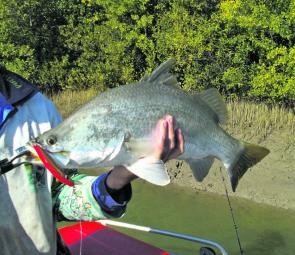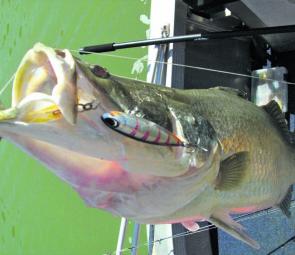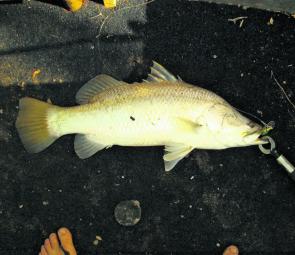In this section, I will be giving tips on how to give a bank side snag a serious luring over.
The basic technique is to continuously cycle over a small number of spots consisting of fallen trees and mangrove roots across various stages of the rise and fall of the tides. In such situations I may never even start the big engine – doing all the work off the bow-mounted electric.
As the tides change I vary my lures, my retrieves and even my boat’s distance from each piece of structure. I also give some of the spots a break for a while to let them cool off.
In tidal water, barra may patrol a collection of spots within their turf around each piece of home structure. Therefore, it is not just the snag that you can target; the breakline or drop-off just out from the snag may be where the barra hold up when the tide falls to the point where the snag is completely out of the water (the fish have to be somewhere).
Alternatively, it could be the midwater snag that you found on your sounder while trolling that now holds the fish. You have to meticulously work all the options when you are picking apart a spot.
Barra tend to adjust their position as to whether the tide is following in or out; they can have different ambush points when the water is flowing from the left or the right. Therefore there will be stages of the tide when the barra will hold on a piece of structure for a while. In these situations I’ve seen the barra appear to be asleep, until the right presentation wakes them up.
It is important to use the changes in tidal flow as a component of where and how you fish your lure. Don’t fight nature, work with it! For example, if you want to get your lure down deep beside the snag then cast up current and work a suspending deep diver quickly to get it into the strike zone. Then pause the lure when you get it deep beside the snag. Most often it will be on the pause when the barra inhales your lure.
If that doesn’t work, switch lures to a very similar but floating deep diver and manoeuvre it into the same spot but this time let it float all the way up. If it bumps a branch on the way up then this may be when the barra will strike; or the barra may wait until the lure’s back finally breaks the surface before it engulfs the lure. The slower the lure rises the better.
I like to bob my lure down and then let it float up to bump into the timber a few times on each retrieve if I can. Pick apart the snag and bump target bits of timber/branches that are in the water. When an object is about to be ambushed the barra will often wait until the lure is up against the timber before the barra strikes – this way the barra knows that the target has one less direction in which it can escape.
Before working the up current side I’ll attack the down current side, particularly to see if there is a barramundi waiting for my lure to splashdown. For instance, when targeting the back of the snag I’ll fire lures in the back pocket from the down current side; therefore my lures will always be taken away from the snag by the current – hence I’m in the strike zone for a miniscule amount of time – but if there is a barra there then my cast will find it. Once clear of the strike zone I may speed up my retrieve to get my lure out of the low percentage water and ready to cast back into the hot zone.
The angle of your line between your boat and the snag can also be important. Essentially, the lure’s track back to the boat may be designed to bump or run alongside bits of branches or it may be designed to be in the clear so that you can fight your fish on light line.
On the other side (up current side) of the snag, using heavier line and heavier leader and stout rod, I may crank a deep diver down deep and let the current drag it into the devil’s danger zone. This isn’t for the faint-hearted and it isn’t for the lure collector. Experiment with a wide variety of lure retrieval options, but you’ll find soft plastics work well in this situation.
It also helps to be well practised in boat control using the foot-controlled electric motor. Likewise, have a rod tip that won’t break when you poke it 1.5m down into the water to bump the lure off a snag.
Due to the higher risk of needing to bash your way into the snag (I may often have three or four lures tangled in the timber before I barge in) I may leave the up current deep diver until last.
Before I bite the bullet on the deep divers, my penultimate trick is to cast well away from the snag on the up current side and angle my retrieve to clip the very tip of the snags in the water. When there are good numbers around there will often be a barra sitting below this very last twig in the water. Sometimes you’ll have to slow your lure down in order to let the current do more of the work; other times you’ll have to speed up your retrieve before the lure gets swept under the snag and into the danger zone (you’ll probably find a mangrove jack, or a cod, in there that will stitch you up anyway).
All of this forces variety into your retrieve. It pays to keep tuned in to what you are doing, because when you do catch a fish it helps to repeat the retrieve on the next few casts to see if you may have stumbled onto a productive pattern.
I’ve talked a lot about the effects of the current, however, sometimes you’ll have no current but lots of wind blowing on your line and pushing it just a little bit sideways. The theory is much the same with either breeze or water current.
Don’t forget that there will be structure in the water that you can’t see and you’ll need to feel around this with your lures and build a picture. This structure includes bits off the snag as well as changes in the bottom depth like holes and breaklines/drop-offs.
In addition to the selection of topwaters, shallow runners and diving lures in floating, suspending and sinking options, you should also have a good selection of jighead t-tail soft plastics and weedless soft plastics. Using each lure to its strength and having a wide cross section of lures will really enable you to pick apart the snag and spend maximum time at each spot rather than ‘gunning and running’.
Of course there’s nothing wrong with ‘gunning and running’ but there are times when it pays to explore a small spot to its full potential. An example would be a small side creek in which only one boat can get in there in an otherwise very busy river. If you happen to be the lucky boat that is in the little honey hole then consider spending your whole session in there.
If you get it right all your barra will be caught on solid hook-ups with the lure inside the barra’s mouth. If you are hooking the barra around the outside of the head and they are throwing your lure, then slow your retrieve down and inject more pauses. Barra would have to be one of the most shut-down sensitive fish that I have ever encountered, so sometimes you just have to be patient with them.
When you pick apart a snag you’ll often be amazed at how many barra are really hiding in there.
The four most important points to lure casting for barra are:
1. Use the current as part of your strategy;
2. Bump the stump with your lure;
3. Inject pauses into the retrieve. Let your lures either drift with the current or to rise and bump into submerged branches (of course the barra love to inhale your lure at this point)
4. Know your lure and know how they perform in the water. The Gold Bomber for example isn’t just a gold minnow lure – there’s the Bomber version, the Halco version and the Bill Norman options. They all swim and/or dive a little differently to exploit different underwater layouts. And gold isn’t the only colour either.
Reads: 7244
With hard bodied lures it is not uncommon to hok barra on the outside of the mouth. This is where the hooks need to be sharp to penetrate well and the angler needs to be aware to not put too much pressure on the fish and risk the hooks pulling.

This small lure was hooked on the outside of the fish’s mouth. Note the use of the large Norman’s Speed Clip to attach the leader to the lure’s front eyelet. This is very popular for quick change lure applications however there is not a lure clip made tha

Barra inhale litres of water when they attack a lure and hook-ups inside their great big mouth are common. This is where a sturdy leader will save the day and see the fish landed more times than not.




